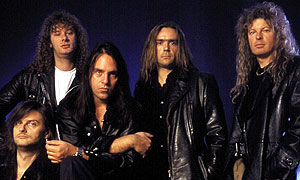| Biography | |||
| |||
Biography of Helloween
Diposting oleh Tiaratech media | 0 komentar | Kamis, 04 Maret 2010di 12.10 |
HISTORY OF EUROPE BAND
Diposting oleh Tiaratech media | 0 komentar |di 11.36 |


The group was formed in 1979 in Upplands Väsby, Stockholm, Sweden by vocalist Joey Tempest, guitarist John Norum, bassist Peter Olsson and drummer Tony Reno, under the name Force. After winning a national music contest, they changed the name to Europe. In 1981, bassist Peter Olsson out and replaced by John Leven. In 1985, drummer Tony Reno replaced the former drummer Ian Haugland Trilogy group. Keyboard player Mic Michaeli also recruited to strengthen the band formation.
[edit] Success of the world
Two limited release first album in 1982 and 1984, Europe and Wings of Tomorrow. Both were received well in Japan and Scandinavia. Europe worldwide and reached a high popularity in the year 1986 through the third album The Final Countdown. This album produced the phenomenal hit "The Final Countdown" which ruled the charts number 1 in 26 countries. [Citation needed] the single sold about 8 million copies. Album alone sold approximately 6.5 million copies. Other songs on this album like "Carrie", "Rock The Night", and "Cherokee" soared to hit the world. The end of 1986 guitarist John Norum out because of differences of opinion with other personnel in the musical direction of Europe.
Kee Marcello, guitarist for glam rock band Easy Action, enter and succeed John Norum Europe at the time was busy on tour. In 1988, Europe released their fourth album Out of This World which spawned the hit Superstitious. Although not as phenomenal previous album, Out of This World was still able to achieve some platinum. After that, Europe successfully toured the world.
In 1991 Europe released a fifth album, Prisoners in Paradise. Compared with the success of two previous multiplatinum albums, this fifth album sales were not too good because it only sold about 1 million copies worldwide. Prisoners in Paradise had scored hits "I'll Cry for You" and the title track with an album of "Prisoners in Paradise".
Many years living in an exhausting tour of Europe to make personnel decided to rest. Plan to rest two years turned out to be longer, a member of Europe became busy with solo careers of each and other projects. Onslaught of grunge music that swept the world come to make most of the hard rock music market as Europe joined buried carried.
[edit] Reunion
In 1999 Europe was invited to a reunion concert. Guitarist John Norum and Kee Marcello agreed to appear together in a New Year's Eve concert in Stockholm. They brought two classic hits of Rock The Night and The Final Countdown at this concert.
After this reunion concert, the news about the reunion of the total pricking. In 2003, Europe decided to return to the rock music scene with their classic formation era of "The Final Countdown", Joey Tempest (vocals), John Norum (guitar), Mic Michaeli (keyboards), John Leven (vocals), and Ian Haugland ( drums). Although offered, guitarist Kee Marcello decided not to join.
In 2004 Europe released the album Start From the Dark which was a fairly warm reception from the fans. Color display is more hard rock hard and thick with bandages thicker guitar, the album sold more than 600,000 copies. Fantastic music presented very different from the color of their music in the era of the 1980s. In 2006 Europe released the album Secret Society which is still the same color as the album Start From The Dark. Europe apparently decided to not return to their sound in the 1980s the melodic. They appear with a more ferocious music who show distortion down-tuned guitars and powerful drum roffel. 9 September 2009 Date of Europe released a new album titled Last Look at Eden.
Langganan:
Postingan (Atom)
 Alongside Switzerland's Celtic Frost and Sweden's Bathory, Germany's Helloween were possibly the most influential heavy metal band to come out of
Alongside Switzerland's Celtic Frost and Sweden's Bathory, Germany's Helloween were possibly the most influential heavy metal band to come out of 
